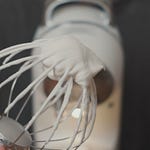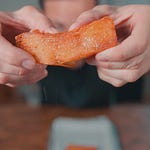The Bao Mac
1 lb of beef, divided into 1 oz balls
4 slices American cheese, halved
Special Sauce
Bao Buns
Sichuan Pickles
Shredded lettuce
Cook burger to your desired doneness, top with cheese and assemble on top of fluffy steamed bao bun with special sauce, lettuce, and pickles
Special Sauce
1/2 cup mayonnaise, I like Best Foods
2 tablespoons sweet relish
1 tablespoon finely minced onion
2 tablespoons Ketchup
2 teaspoons Chinese mustard
1 teaspoon white vinegar
1/2 teaspoon smoked paprika
1/4 teaspoon salt
1/4 teaspoon garlic powder
Sichuan Pickles
1 large English cucumber, sliced 1/8 inch thick on a mandoline
2 cloves garlic, lightly crushed
Slice the cucumbers and place them into a large container with the garlic
1/2 teaspoon Sichuan peppercorns
2 dried red chilis
1/2 cup distilled white vinegar
1 cup water
2 teaspoons Soy sauce
1 tablespoon sugar
Toast the peppercorn and chili in a medium pot over medium flame until fragrant, about 45 seconds, add the remaining ingredients and bring to a boil. Once the sugar is dissolved pour over the cucumber and garlic and place in the fridge overnight
Bao Dough inspired by Wei Guo
300 g all-purpose flour see note 1 for substitutes
1¼ teaspoon instant yeast see note 2 for substitutes
1 teaspoon baking powder
1 teaspoon white sugar
185 g lukewarm water, or milk see note 3
Oil for brushing
Sesame seeds optional
Manual Method: In a large bowl, mix flour, instant yeast, baking powder and sugar (see note 2 if using dry active yeast or fresh yeast). Gradually add water/milk while stirring with chopsticks. Combine and knead by hand until a rough-looking dough forms. Rest for 10 minutes then knead for 2-3 minutes until it becomes very smooth.
Stand-mixer Method: Add flour, instant yeast, baking powder, sugar and water/milk to the mixing bowl (see note 2 if using dry active yeast or fresh yeast). Mix and knead with a dough hook on low speed for 8-10 minutes until a smooth dough forms.
Shape the bao buns
Rolling pin method: Roll the dough into a rope. Divide into 8-12 equal pieces. Roll them into balls then flatten each with a rolling pin into an oval shape, about ⅕ inch (½ cm) thick (dust with flour when necessary to prevent sticking). Brush a thin layer of oil over half of the oval then fold over lengthways.
Cutter method: Flatten the dough with a rolling pin into a rectangle, about ⅕ inch (½ cm) thick. Use a large round cutter to cut out circles, then roll each piece into an oval shape. Combine the leftover dough and repeat to cut out more (dust with flour when necessary to prevent sticking). Brush oil over half of the oval then fold over lengthways.
Rest
Line the steamer baskets with perforated parchment paper or silicone steamer liners (or oil the surface if using metal or plastic steamers). Place the bao buns over leaving enough space in between for expansion.
Leave to proof for about 30 minutes (see note 4) until the buns become a little bigger, plumper and feel lighter in weight.
Steam
Add 2 cups (500ml) of water to the wok or pot that you use for steaming. Place the baskets on top (you may stack up several and cook all at once). Cover with a lid.
Firstly, cook over high heat. As soon as the water starts to boil (when you see steam coming out through gaps), turn the heat to medium-low. From this moment, steam for 10 minutes.
Store
Once completely cool, store leftover buns in the fridge for up to 4 days or in the freezer for 2 months. Reheat by steaming them for 5 minutes if chilled or 7 minutes if frozen.
Make ahead
Cook them as instructed above then freeze them once cooled (It’s not recommended to freeze uncooked bao buns as the yeast dough doesn’t rise properly after freezing).
Defrost them in the fridge overnight then steam for 5 minutes before serving. Or, reheat them without defrosting for 7 minutes.
Notes
1. You may use low-gluten cake flour or high-gluten bread flour to substitute. If using the latter, replace ⅕ of the flour with cornstarch to reduce the chewiness of the buns.
2. If using dry active yeast or fresh yeast, you’ll need to activate it first by mixing it with sugar and lukewarm water/milk. Let it sit for 5 minutes until foamy then mix with flour and baking powder.
3. The water/milk quantity may vary slightly depending on the brand and type of your flour. Adjust accordingly. The dough should be soft but not at all sticky.
4. The proofing time required may vary depending on the room temperature. It takes me about 30 minutes when it’s around 72-77°F (22-25°C). Slightly reduce the time if your kitchen is warmer, or prolong it a little if it’s cooler.










